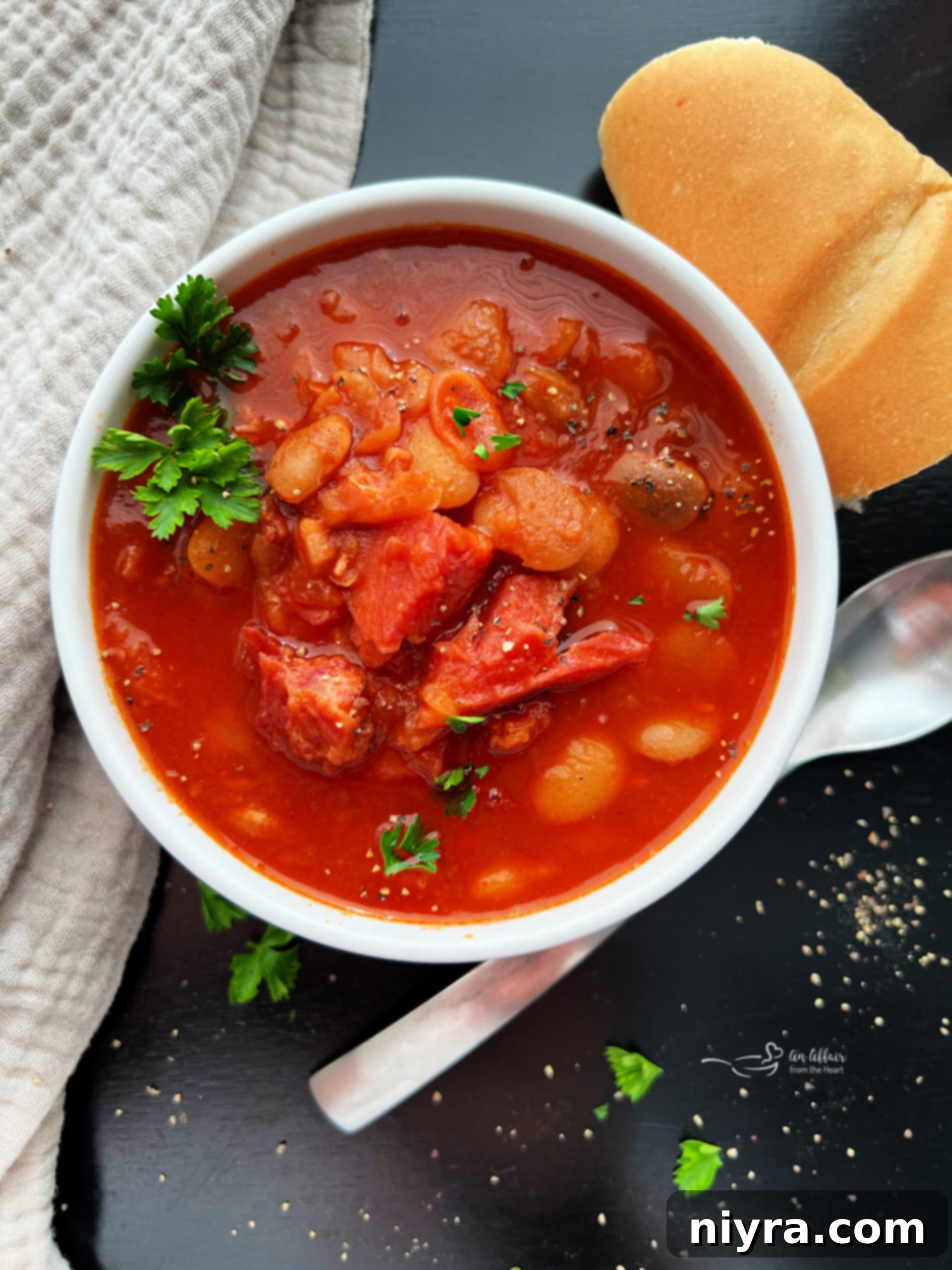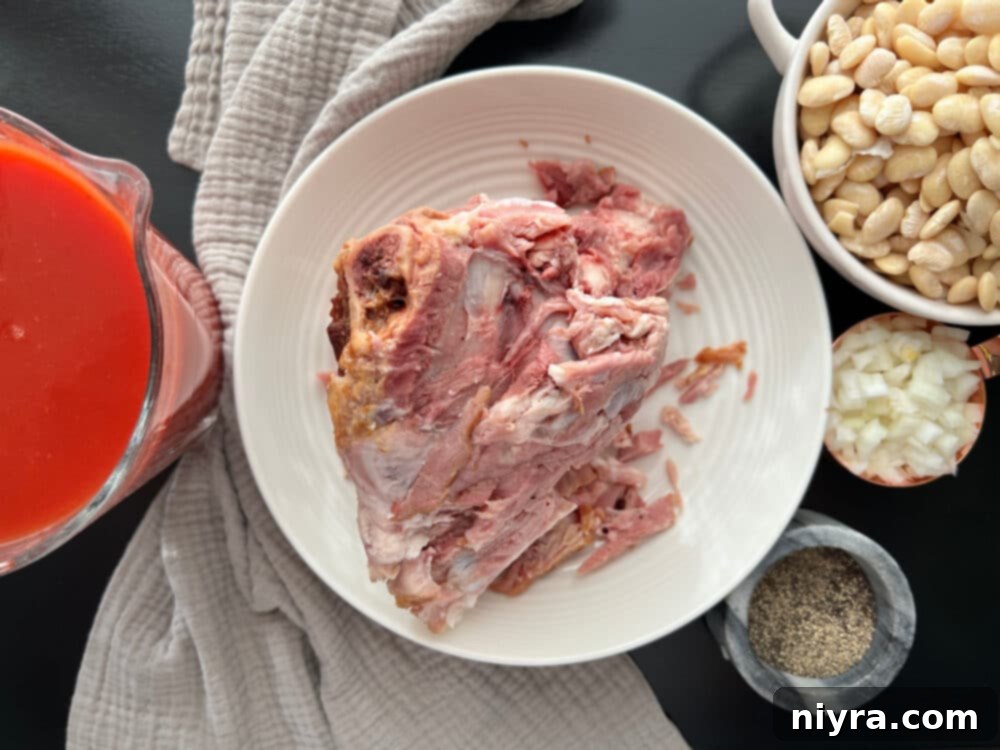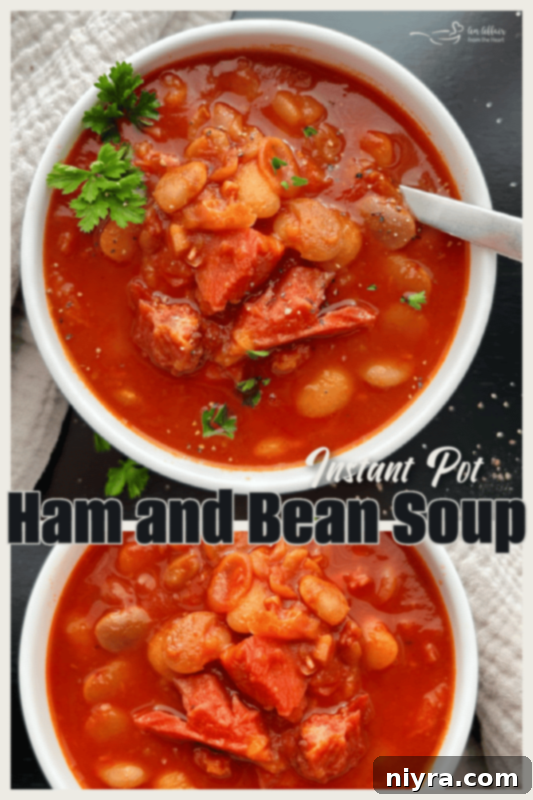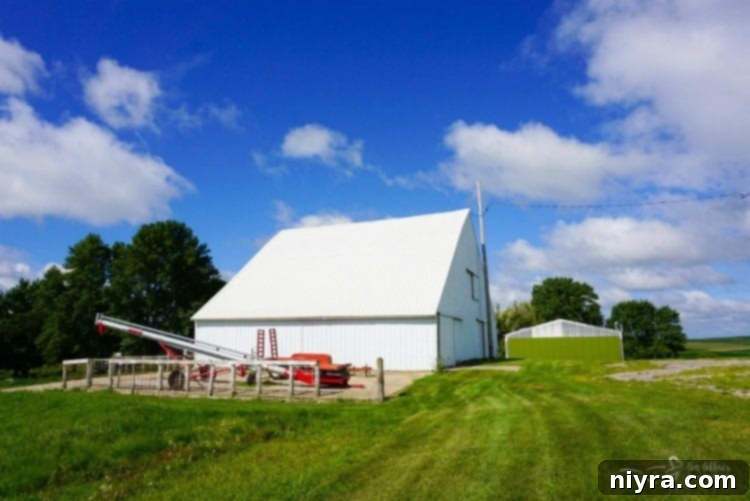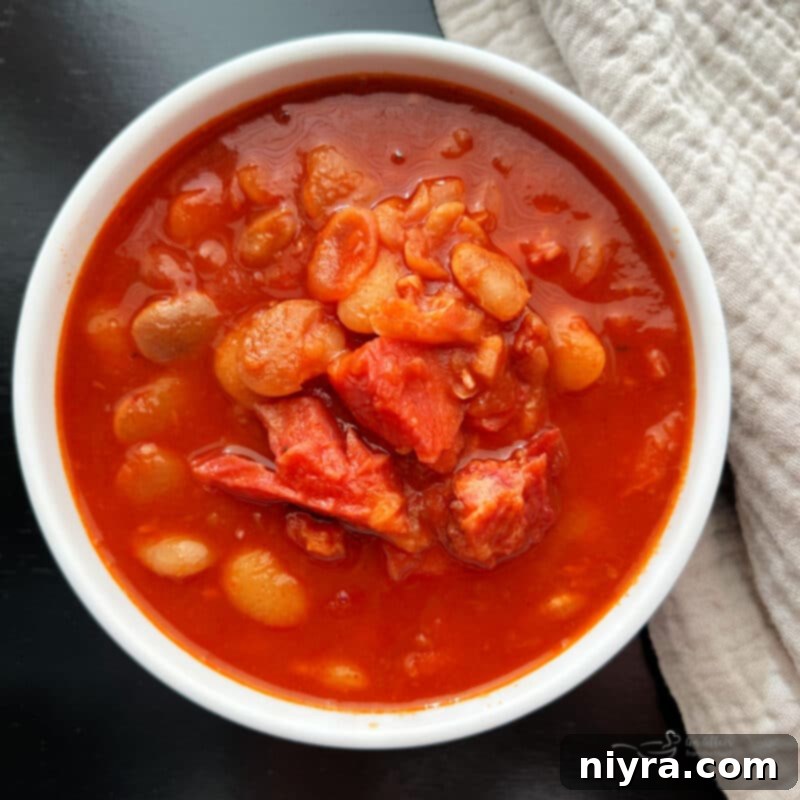Discover the ultimate comfort food with this incredibly easy recipe for **Instant Pot Ham and Bean Soup**. Designed for speed and simplicity in your pressure cooker, this hearty soup offers a wholesome, nourishing meal perfect for chilly days. Imagine a thick, rich tomato broth brimming with savory ham and tender lima beans – a flavor combination that truly satisfies. This **Instant Pot Ham and Bean Soup** recipe isn’t just a meal; it’s an essential experience for soup season, guaranteeing warmth and deliciousness in every spoonful.
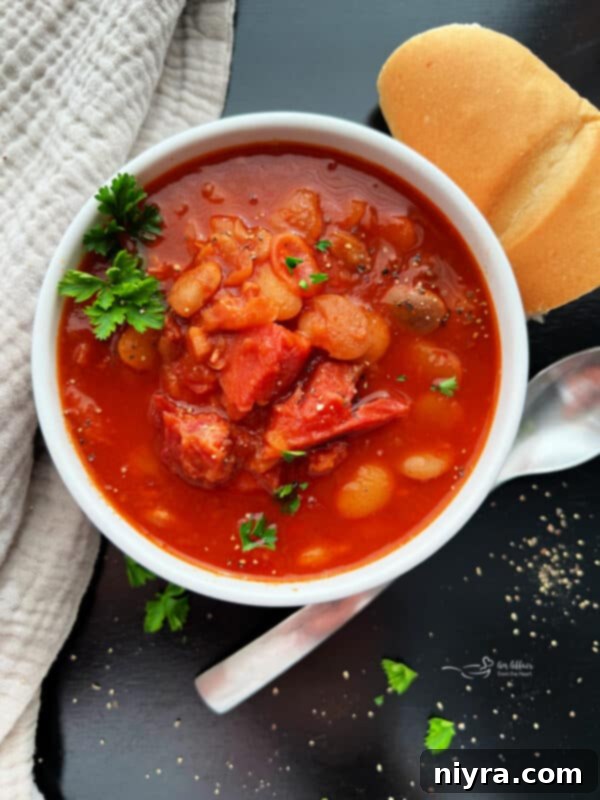
For our family, Christmas Eve holds a cherished tradition: my mom always prepares a magnificent bone-in spiral-cut ham. This particular holiday ritual is one of my favorites, largely because of its comforting predictability. Each year, the menu is precisely the same: the star attraction, ham, accompanied by our beloved Broccoli, Rice & Cheese Casserole, creamy Hashbrown Potato Casserole, sweet corn, and freshly baked rolls. It’s a feast that not only fills our bellies but also warms our hearts with nostalgic flavors and shared memories.
The joy of the Christmas ham doesn’t end with the holiday dinner, though. The following week, a new tradition unfolds as mom transforms the delicious leftovers into this incredible Ham & Bean Soup. She uses her trusty old-style pressure cooker, a kitchen staple that has been a fixture in our home for as long as I can remember. This soup is more than just a leftover meal; it’s a testament to timeless family recipes and the enduring magic of a home-cooked tradition.
This specific soup recipe has a rich heritage, originating from my grandma, my mother’s own mom. Grandma affectionately called it “Lima Bean Soup,” but through the years, my mom and our family have always referred to it as simply “Ham and Bean Soup.” This cherished recipe is the ideal way to gather the entire family around the table for a warm, comforting bowl of soup. It’s wonderfully versatile, perfect for a quick and satisfying weeknight dinner or a leisurely weekend lunch. And here’s a little secret: it tastes even better the next day, assuming you’re lucky enough to have any leftovers!
This post is proudly sponsored by Iowa Pork. The opinions expressed here, along with my deep appreciation for Iowa Pork products, are entirely my own. We only share brands and products we genuinely love and trust in our kitchen.
PLEASE NOTE: SOME OF THE LINKS BELOW ARE AFFILIATE LINKS. AS AN AMAZON SERVICES LLC ASSOCIATES PROGRAM PARTICIPANT, I MAY EARN FEES FROM QUALIFYING PURCHASES MADE THROUGH LINKS TO AMAZON.COM AND AFFILIATED SITES. I ALSO PARTNER WITH OTHER BRANDS. REST ASSURED, I ONLY RECOMMEND PRODUCTS I PERSONALLY USE, LOVE, AND BELIEVE YOU WILL APPRECIATE TOO. FOR A FULL UNDERSTANDING OF MY DISCLOSURE POLICY, PLEASE CLICK HERE.
Grandma’s Signature Ham and Bean Soup: A Flavorful Twist
When guests first encounter our family’s ham and bean soup, many are quite surprised by its distinctive color. My husband, for instance, initially expected a lighter, more traditional white soup, much like the one his mother prepared. However, our cherished family recipe stands out for a unique reason: it calls for tomato juice instead of the more common chicken stock or plain water. This simple substitution isn’t just for aesthetics; it profoundly intensifies the flavor, creating a wonderfully rich, savory, and subtly sweet broth that truly elevates the entire dish. It’s a secret ingredient that makes all the difference, transforming a classic comfort food into something truly special and memorable.
The use of tomato juice imparts a vibrant, tangy depth that perfectly complements the smoky, salty notes of the ham and the earthy sweetness of the beans. This unexpected twist creates a more complex and satisfying flavor profile that sets our family’s Ham and Bean Soup apart from others. It’s this particular characteristic that makes it a beloved staple, eagerly anticipated every winter. If you’ve never experienced ham and bean soup with a tomato base, prepare for a delightful culinary revelation!
Mastering Frugality: Creative Ways to Utilize Leftover Ham
In today’s economic climate, where grocery prices seem to climb higher each week, being resourceful in the kitchen is more important than ever. This year, I’ve made it my mission to empower my readers with strategies to stretch their food budgets and transform single meals into a multitude of delicious options. My Grandma’s Ham and Bean Soup is an exemplary illustration of this philosophy in action. It’s a prime example of how to maximize flavor and minimize waste, turning one magnificent ham into several delightful culinary experiences.
My grandma was a master of frugality, a principle deeply rooted in her cooking. She never let good food go to waste, and her culinary prowess shines through in this soup. It demonstrates how ingeniously using the ham bone from a previously cooked ham, combined with a few readily available pantry staples, can yield a deeply warm, comforting, and remarkably flavorful meal. The ham bone, often discarded, becomes the foundation of an incredibly rich broth, imparting a depth of flavor that simply cannot be replicated with store-bought stock.
Beyond this satisfying soup, leftover ham offers a treasure trove of culinary possibilities. Don’t let those delicious scraps go to waste! Consider incorporating them into dishes like Hawaiian Ham Balls for a sweet and savory appetizer, or elevate your breakfast or brunch with a sophisticated Smoked Ham & Gouda Quiche. For a comforting casserole, leftover ham can be a fantastic addition to dishes like Chicken Cordon Bleu Casserole (by substituting chicken with ham). These ideas showcase how versatile leftover ham can be, allowing you to create diverse and exciting meals without breaking the bank.
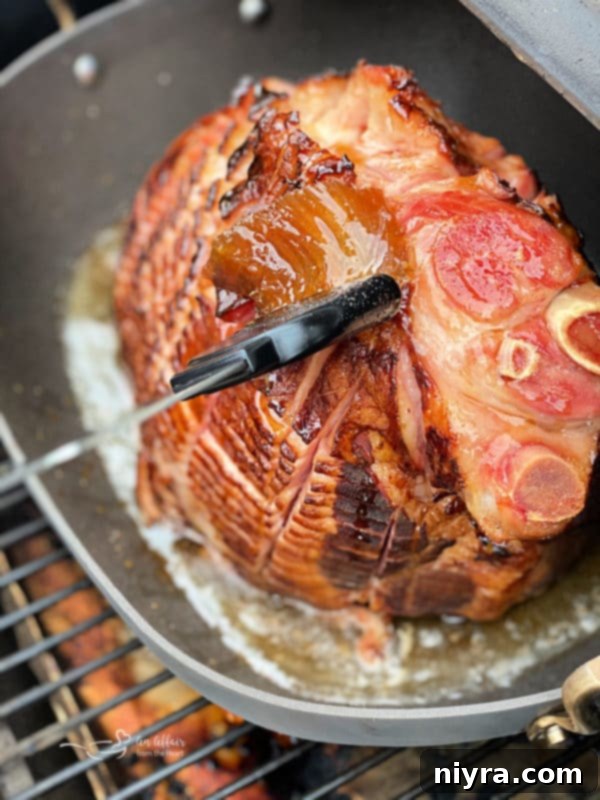
Understanding Ham: Smoked vs. Cured and Everything in Between
Navigating the world of ham can sometimes be a bit confusing, especially when terms like “smoked” and “cured” are often used interchangeably or without clear distinction. To clarify, let’s break down the differences. A “cured ham” means the meat has undergone a preservation process, typically by being soaked in a brine solution containing salt, sugar, and sometimes nitrates. This curing process adds flavor and extends shelf life. Cured hams can be sold either fully cooked (ready to eat) or uncooked (requiring cooking before consumption).
Adding another layer of complexity, you’ll also encounter “fresh” hams, as well as hams that are “smoked and cured.” A “fresh ham” simply refers to the specific cut of pork – it’s the hind leg of the pig, similar to a fresh pork roast. Crucially, a fresh ham is neither cured nor cooked, meaning it must be both cured and fully cooked before it’s safe and delicious to eat. This is a vital distinction for home cooks. You’ll typically find fresh ham only by special request from your butcher, as it requires specific preparation.
In contrast, the hams you commonly see in the meat department of your local grocery store are usually a combination of processes. They are typically cooked, cured, and often smoked. The smoking process, which involves exposing the ham to wood smoke, imparts a distinctive flavor and aroma that many people associate with traditional ham. Always check the label carefully: it will clearly state if the ham is “ready to eat” or if it “must be cooked” before serving. This information is key to ensuring proper food safety and achieving the best culinary results.
The beautiful photos you see here feature a Double Smoked Ham with a Homemade Honey Glaze. This is our absolute favorite way to prepare ham at home, typically cooked to perfection on our Traeger grill, resulting in incredibly tender and flavorful meat.
Achieving Perfection: The Importance of Internal Ham Cooking Temperature
You might be wondering if the internal cooking temperature of ham truly matters, especially if it’s already labeled as “smoked” or “precooked.” The answer is an emphatic yes! Even if a ham has been previously cooked or smoked, when you’re reheating it at home, you still need to ensure it reaches a safe internal temperature. For previously cooked or smoked hams, the goal is an internal temperature of 140 degrees Fahrenheit (approximately 60 degrees Celsius), as verified with a reliable meat thermometer. This ensures that the ham is thoroughly heated and safe for consumption, bringing out its best flavor and texture.
Using a meat thermometer is not just a recommendation; it’s a best practice that guarantees food safety and optimal results. Inserting the thermometer into the thickest part of the ham, avoiding the bone, will give you the most accurate reading. For comprehensive guidance on pork preparation, including precise cooking times and temperatures for every cut of pork, the Iowa Pork Producers Association offers an invaluable resource. Their website features an incredibly handy guide that I highly recommend bookmarking. It’s a fantastic tool to easily refer to, ensuring you cook all your pork dishes perfectly every time, from roasts to chops and, of course, your holiday ham.
Knowing When Your Ham & Bean Soup is Done to Perfection
When it comes to preparing this delightful Ham & Bean Soup, you won’t need to play guessing games about the doneness of your ham. The beauty of using a leftover ham bone (or ham hocks/shanks) is that the ham itself is already cooked prior to being added to your Instant Pot or pressure cooker. The cooking time in the Instant Pot is primarily focused on extracting all that wonderful flavor from the ham bone and ensuring the beans reach their ideal tender consistency.
You’ll know your soup has reached perfection when two key indicators are met: first, the delicious pieces of ham should be effortlessly falling off the bone, ready to be shredded and mixed back into the rich broth. Second, the lima beans should be wonderfully tender, offering a creamy texture that melts in your mouth without being mushy. These signs confirm that all the flavors have melded beautifully and the soup is ready to be savored.
Essential Ingredients for Your Delicious Ham and Bean Soup
Below, you’ll find a detailed list of the core ingredients required for this heartwarming Ham and Bean Soup. For the comprehensive instructions and precise measurements, please refer to the printable recipe card conveniently located at the very end of this post. We believe in keeping things simple and flavorful, using readily available items to create a truly memorable meal.
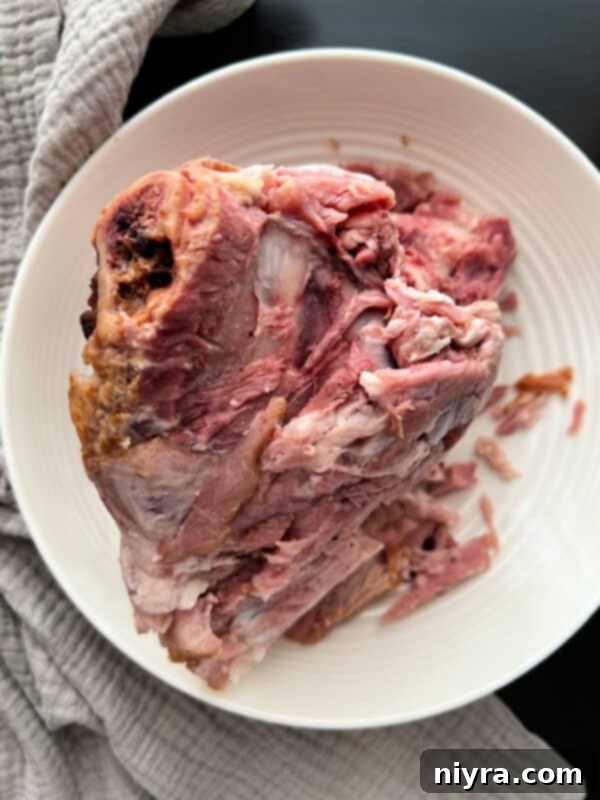
- Hambone – The cornerstone of this flavorful soup! I typically use one ham bone with a decent amount of meat still clinging to it, usually from a holiday ham. However, if you don’t have a leftover ham bone, you can readily substitute with meaty ham hocks or ham shanks, which will also infuse the soup with incredible depth. For a particularly meaty soup, feel free to chop up some additional cooked ham (purchased from the grocery store or leftover) and toss it in alongside the bone.
- Tomato Juice – This is our family’s secret ingredient that sets this soup apart. I use a full quart of good quality tomato juice. It provides a rich, slightly tangy broth that complements the ham and beans beautifully, creating a depth of flavor unmatched by plain water or broth.
- Onion – A foundational aromatic, a diced half of a medium onion (any common cooking onion like yellow or white will work perfectly) adds a subtle sweetness and savory base to the soup.

- Lima Beans – The essential bean for this classic recipe. I use one standard package of dried lima beans. Their creamy texture and distinct flavor are perfect for soaking up the rich broth.
- Baking Soda – A clever addition, a small amount of baking soda serves a dual purpose. Firstly, it helps to tenderize the beans, allowing them to cook faster and more evenly. Secondly, it can aid in reducing some of the gastrointestinal discomfort often associated with eating beans, making the soup more enjoyable for everyone.
- Water – Simple tap water is all you need for the crucial overnight soaking process of the lima beans, preparing them for optimal cooking.
- Black Pepper – Freshly ground black pepper is my seasoning of choice, adding a subtle warmth and aromatic kick. While white pepper can be used, be aware that it will impart a slightly smokier and more pungent flavor, which might alter the traditional taste of this recipe. Given the inherent saltiness of ham, we typically don’t add additional salt to the soup, allowing the ham’s flavor to shine.
Step-by-Step: Crafting Your Delicious Ham and Bean Soup
This recipe is designed for simplicity, making it a quick and easy way to create a deeply satisfying meal using an economical ham bone and just a few essential, budget-friendly ingredients. Follow these steps to bring a taste of comforting homemade tradition to your table.
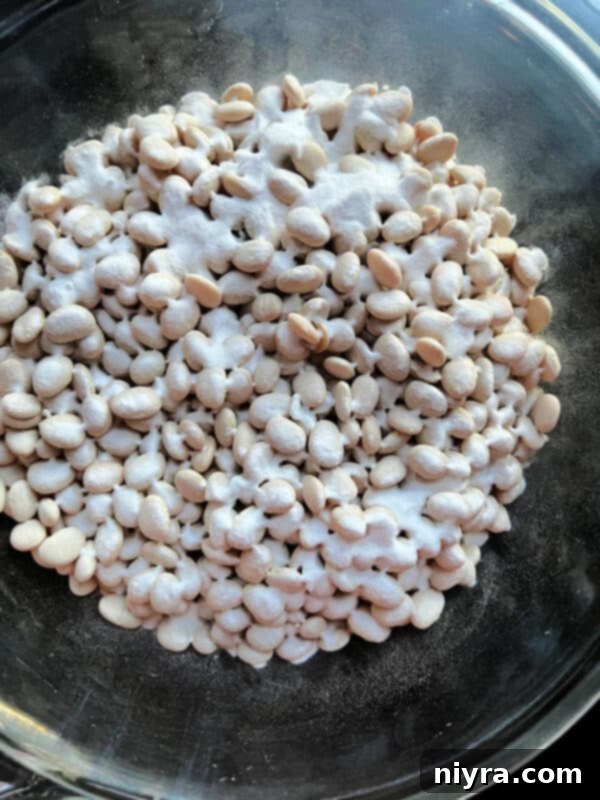
**The Night Before (or at least 8 hours prior):** Begin by thoroughly rinsing your dried lima beans under cool running water. Transfer the rinsed beans to a shallow baking dish or a large bowl. Sprinkle them evenly with baking soda, then cover them generously with cold water. Allow the beans to soak overnight, or for a minimum of 8 hours. This crucial soaking step helps tenderize the beans and aids in digestion. Before proceeding with the recipe, be sure to discard all of the soaking water.
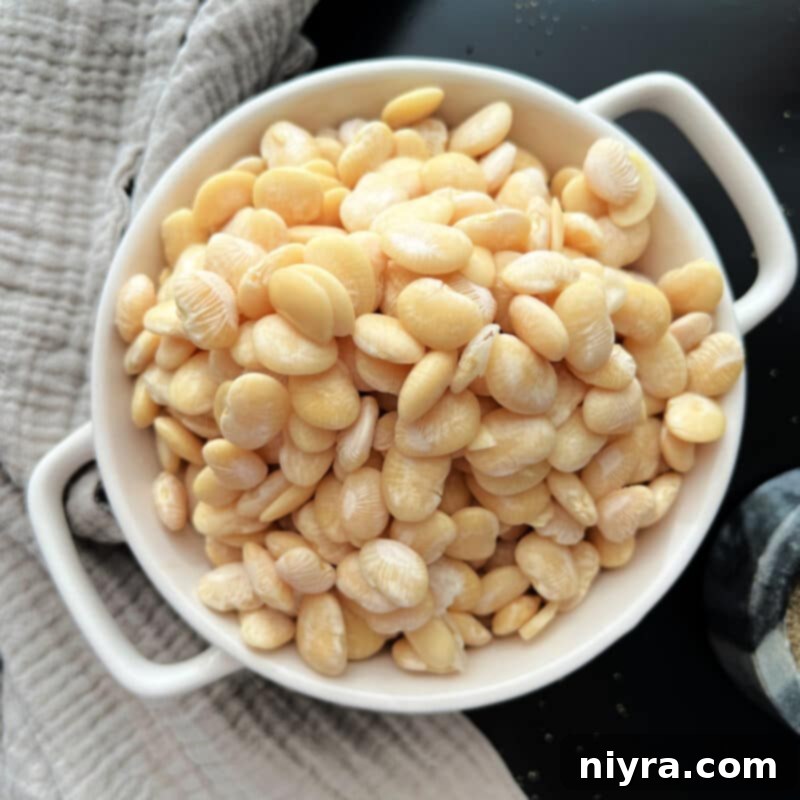
After soaking, give the lima beans another good, thorough rinse under cool water. This washes away any residual baking soda and prepares them for cooking, ensuring a clean flavor profile in your soup.

Carefully place your ham bone (or ham hocks/shanks) into the inner pot of your pressure cooker. This bone will be the flavor base for your entire soup.
**Chef’s Tip:** To ensure maximum flavor and yield more tender ham pieces for your soup, it’s a great idea to intentionally leave some ham clinging to the bone when you originally carve your ham. Alternatively, if your bone is bare, you can dice up any leftover cooked ham or purchase a small amount of quality ham from your grocery store to add into the soup before cooking for extra meatiness.
Next, add the thoroughly rinsed and soaked beans to the pressure cooker alongside the ham bone. Pour in the quart of tomato juice, which will form the rich broth, and add the chopped onion. Finally, sprinkle generously with freshly ground black pepper. This is typically the only seasoning needed, as the ham provides ample saltiness.
**A Note on Beans & Salt:** When my mom prepares this soup, she often uses about two-thirds of the soaked beans, which amounts to roughly 3 cups. I also adopt this approach, as I personally prefer a soup with a more generous amount of broth. Keep in mind that beans tend to absorb a significant amount of liquid as they cook. If your preference leans towards a thicker, heartier soup, feel free to use all of the soaked beans. Both my mom and I consistently avoid adding extra salt to this recipe because the ham, particularly if it’s cured or smoked, contributes plenty of natural saltiness, ensuring a perfectly balanced flavor profile.
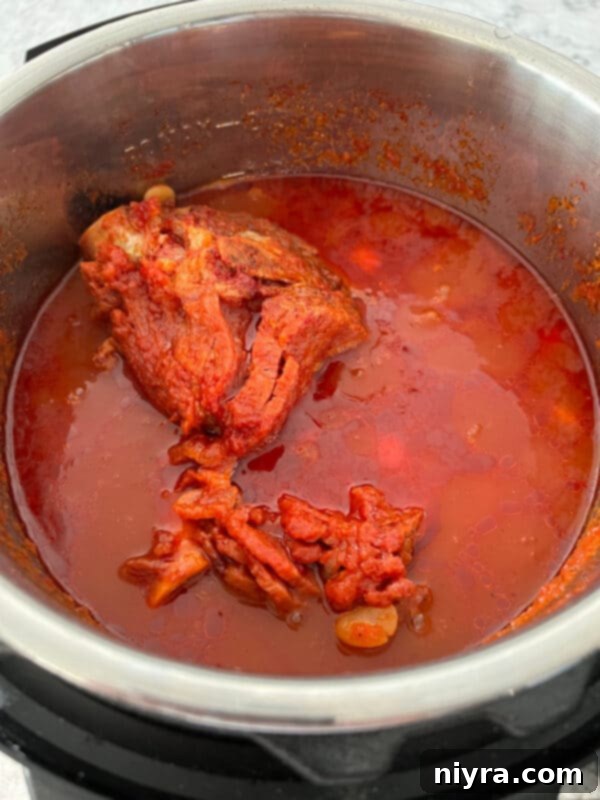
Secure the lid on your Instant Pot, ensuring the vent is in the sealing position. Set your Instant Pot to the “Manual” (or “Pressure Cook”) setting for 25 minutes on high pressure. Once the cooking cycle is complete, allow the Instant Pot to naturally release pressure for 10 minutes. This “slow release” method helps to prevent the beans from bursting and ensures a creamier texture. After 10 minutes, carefully manually release any remaining pressure by turning the vent to the venting position before safely removing the lid.
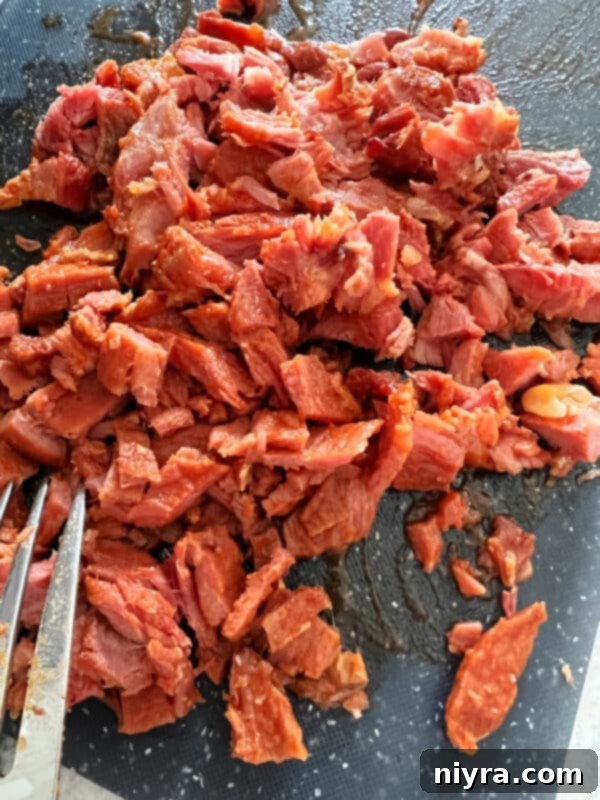
Carefully remove the ham bone from the pot. Once it’s cool enough to handle, strip any remaining ham from the bone and chop or shred it into bite-sized pieces. Return this flavorful ham back into the soup. Stir everything together, and your comforting Ham and Bean Soup is ready to be served hot. Garnish with fresh parsley if desired, and enjoy!
Versatile Cooking: Other Methods for Making Ham and Bean Soup
While the Instant Pot offers unparalleled speed and convenience, this classic Ham and Bean Soup can be equally delicious when prepared using other traditional cooking methods:
To make ham and bean soup in the Crock Pot (Slow Cooker), follow the same initial preparation steps for soaking and rinsing the beans. Place the ham bone, soaked beans, tomato juice, onion, and black pepper into your slow cooker. Cook on the low setting for 6-8 hours, or until the beans are tender and the ham easily falls from the bone. The slow cooking process allows the flavors to meld beautifully, creating a rich and deeply satisfying soup with minimal effort.
To cook the soup on the stovetop in a heavy-bottomed Dutch oven, a large soup pot, or a spacious stockpot, begin by preparing your beans as instructed (soaking and rinsing). Combine the ham bone, soaked beans, tomato juice, chopped onion, and black pepper in your chosen pot. Bring the mixture to a gentle boil, then reduce the heat to low, cover the pot, and simmer for approximately 90 minutes. Continue cooking until the beans reach your desired tenderness and the ham effortlessly separates from the bone. Stir occasionally to prevent sticking and ensure even cooking.
Loving This Recipe? Pin It for Later!
If this delightful Ham and Bean Soup recipe has captured your heart and taste buds, make sure you keep it handy! Don’t let this comforting meal slip away. Pin it directly to your favorite Pinterest recipe board right now before you leave. That way, you’ll always have this fantastic recipe at your fingertips for those moments when you crave a truly satisfying bowl of homemade goodness!
DID YOU KNOW THAT AN ASTOUNDING ONE-THIRD OF ALL PORK PRODUCED IN THE UNITED STATES ORIGINATES FROM IOWA?
Many of you might not be aware of this, but my husband’s roots run deep in rural Iowa. He grew up on a family farm in Earling, where his father diligently cultivated corn and soybeans, raised hogs, and also managed a local fertilizer and anhydrous business. It was a life intricately tied to the land and the livestock, fostering a profound respect for agriculture.
My first visit to the farm to meet his parents was quite memorable. They found it amusing to have a “city girl” like me in their midst. I know, for those of you hailing from metropolises like New York City or Los Angeles, the thought of “Omaha as a big city?” might sound quaint. But compared to his hometown, with a population of only 300, Omaha indeed felt like a bustling urban center! Before then, I had never seen a hog up close, nor did I even know what a combine harvester was. In the early years of our marriage and family, we spent countless weekends there. Our children grew up with the unique experience of riding in tractors, hand-feeding the farm cats, and understanding the significance behind the phrase, “that’s the smell of money,” a familiar scent on the farm.
You see, those crops and those hogs were more than just commodities; they were the very livelihood of his family. This connection to the land and livestock is a story shared by countless farming families across the nation. When you choose to purchase pork from your grocery store, whether you’re shopping in Iowa or anywhere else across the United States, you are directly supporting these dedicated local family farms, not just in Iowa, but throughout the country. It’s a powerful connection between your plate and their hard work.
Regardless of the size of the farm, be it a small, generational operation or a larger, modern agricultural enterprise, it’s crucial to remember that there is always a devoted family working behind the scenes. They pour their hearts, sweat, and expertise into raising healthy animals and growing vital crops, all to bring quality food to our tables. By choosing pork, you’re not just buying a product; you’re supporting an integral part of our nation’s agricultural heritage and the families who sustain it.
Frequently Asked Questions About Ham & Bean Soup
Here are answers to some of the most common questions about making a perfect Ham & Bean Soup:
- What kind of beans do you put in ham soup? While this particular recipe proudly features classic lima beans for their creamy texture and distinctive flavor, you have plenty of flexibility! Many other white beans work wonderfully. Consider using cannellini beans (white kidney beans), navy beans, or great northern beans. These varieties offer similar hearty textures and absorb the rich broth beautifully. Before making an extra trip to the grocery store, it’s always a good idea to check your pantry to see if you already have one of these versatile white beans on hand.
- How do you thicken Ham and Bean Soup? If you desire a thicker, more robust soup, there are several effective methods. You can simply add more beans or a tablespoon or two of tomato paste for a richer consistency and deeper flavor. Another common technique is to create a cornstarch slurry (a mixture of cornstarch and a small amount of cold water) or a flour slurry, and slowly stir it into the simmering soup until it reaches your preferred thickness. For a creamier, naturally thickened soup, I sometimes use an immersion blender to carefully purée a portion of the soup, or mash some of the beans directly in the pot with a potato masher.
- What to add to beans to make them taste better? To elevate the flavor profile of your beans, fresh herbs are a fantastic addition. Consider stirring in chopped fresh parsley or a sprig of rosemary towards the end of cooking for a vibrant aroma. If using dried herbs, a pinch of dried thyme or a few bay leaves added to the pressure cooker at the beginning will infuse the soup with a lovely herbaceous depth. A dash of smoked paprika can also add a subtle complexity.
- What kind of beans do you put in ham and beans? As mentioned, while this specific recipe highlights lima beans, the beauty of “ham and beans” is its adaptability. Feel free to use your personal favorite white bean or whatever you have available. Great northern, navy, or cannellini beans are all excellent choices that pair well with ham.
- Why are my beans mushy in Instant Pot? Mushy beans in an Instant Pot are typically a sign of overcooking. Pressure cookers are very efficient, and beans can become soft quickly. Also, canned beans are generally softer and more prone to getting mushy compared to dried beans. To prevent this, always ensure you’re using the correct cooking time for your specific bean type and whether they’ve been pre-soaked.
- Do I need to soak beans before cooking in Instant Pot? There’s a lively debate among cooks regarding whether to soak beans before using an Instant Pot. Many recipes suggest no-soak methods for convenience. However, I was taught by my Mom and Grandma to always soak beans, a tradition I’ve continued. And as they say, “If it isn’t broken, don’t fix it!” Soaking can lead to more evenly cooked beans and may aid in digestion. For this recipe, soaking is recommended.
- Can you overcook beans in Instant Pot? Absolutely! Like any cooking method, it’s possible to overcook beans in an Instant Pot. To avoid this with this recipe, always check for doneness right at the 25-minute mark. If they are not quite tender enough, you can always cook them for a few more minutes under pressure or simmer on “Saute” mode until perfect.
- Do you pressure cook beans on high or low? For dried beans in a pressure cooker, I highly recommend cooking them on the high-pressure setting. This ensures the fastest and most efficient cooking, breaking down the bean fibers effectively.
- How long does it take to cook dried beans in a pressure cooker? The cooking time for dried beans in a pressure cooker can vary slightly depending on the type and freshness of the bean, as well as whether they’ve been soaked. Generally, soaked dried beans will take between 20 to 30 minutes on high pressure to become tender, plus natural or quick pressure release time.
Simple Substitutions to Customize Your Soup
Feel free to adapt this recipe to your preferences or what you have on hand. Here are some easy substitutions:
**Beans:** Instead of lima beans, you can swap in other white beans such as cannellini, white kidney, navy, or great northern beans. Keep in mind that the cooking time provided is specifically for soaked, dry beans, not pre-cooked canned beans, which will require much less cooking time if added at the end.
**Tomato Base:** If tomato juice isn’t available or you’d like a different flavor profile, consider using clamato juice for a savory, slightly spiced twist, or vegetable juice for a milder, garden-fresh taste.
**Liquid Base:** While the recipe primarily uses tomato juice, you can enhance the depth of flavor by replacing some or all of the water (if you add any for thinner soup) with chicken broth, vegetable broth, or even ham stock (if you have it). This will add another layer of savory richness to your soup.
Pro Tips and Smart Tricks for Your Ham and Bean Soup
Maximize convenience and flavor with these handy tips and tricks:
**Freezer Stash:** Always keep a smoked ham hock or a small portion of leftover ham bone in your freezer. This way, you’ll be ready to whip up this comforting soup at a moment’s notice, as most other ingredients are shelf-stable pantry items.
**Waste Not, Want Not:** Never throw away a leftover ham bone or any remaining holiday ham! These are treasures. Simply store them in an airtight container or freezer bag in the freezer until you’re ready to make a batch of this delicious soup.
**Batch Cooking & Freezing:** This soup freezes exceptionally well. Consider making a double batch; enjoy half now and stash the other half in an airtight, freezer-safe container for a future meal. Freezing homemade meals is a fantastic strategy to ensure you always have wholesome, ready-to-eat food on hand, especially during busy weeks. When you’re ready to enjoy, simply rewarm the delicious soup over medium heat in a saucepan on the stovetop until heated through.
**Cooling Convenience:** There’s no need to bring the soup to room temperature before placing it in the fridge or freezer. As soon as it’s cooled enough to handle safely, transfer it to your storage containers and refrigerate or freeze promptly to maintain freshness and safety.
EXPLORE MORE DELICIOUS PORK RECIPES AND CULINARY INSPIRATION
At our family table, pork is a frequent and much-loved guest, no matter the cut or preparation method. Pork is not only incredibly versatile but also packed with essential protein and has earned a well-deserved reputation as a lean, healthy “white meat.” Its adaptability allows for endless culinary creations, from quick weeknight meals to festive holiday roasts, making it a staple in kitchens across the country.
For those interested in the nutritional benefits, it’s worth exploring how pork compares nutritionally to other popular meats. You can also find an excellent guide to the leanest cuts of pork, along with insights into how pork producers have diligently responded to consumer demands for leaner, healthier pork options. These resources are fantastic for making informed dietary choices while still enjoying the rich flavors of pork.
Here are even more fantastic pork recipes for you to explore and enjoy:
- Pork Chops with Mushroom Gravy (pictured above for inspiration!)
- Smoked Pork Loin – A wonderfully flavorful and tender cut.
- Baked Pork Chops with Stuffing & Mushroom Gravy – A complete and comforting meal.
- Sweet & Spicy Bacon-Wrapped Pork Ribs – An irresistible crowd-pleaser.
- Green Chile Quiche with Sausage – Perfect for breakfast or brunch.
- Breaded Pork Cutlets – Crispy, tender, and quick to prepare.
- Fuggedaboutit Pork Roast – So easy, you’ll forget it’s cooking!
- Slow Cooker Glazed Ham – Effortlessly delicious for any occasion.
- Five Bean Ham & Rice Salad – A lighter, refreshing way to enjoy ham.
Don’t Miss Out! Discover More Recipes!
Be sure to check out all of my Soup Recipes for more comforting bowls, explore my Instant Pot Recipes for quick and easy meals, and browse through my comprehensive collection of Pork Recipes for every occasion!
Stay connected and inspired with Iowa Pork! Follow them on Instagram,Facebook,Pinterest, and Twitter for delicious pork recipes and updates all year long! They are a fantastic resource for all things pork.
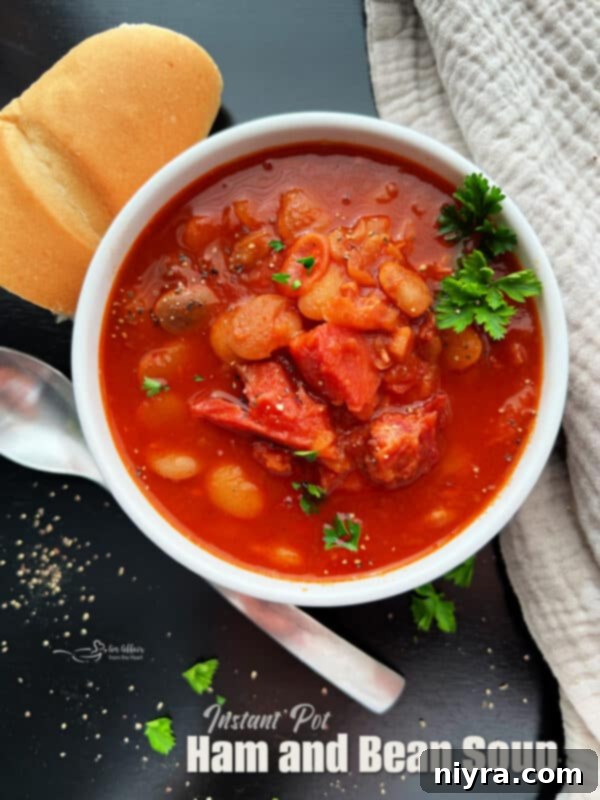
Every single time I prepare this Ham and Bean Soup recipe, it does so much more than just warm my body; it truly warms my soul. Knowing that I am continuing a cherished family tradition, and that my grandma would be absolutely thrilled I’m still enjoying this soup decades after she first made it for me, fills me with immense joy. It’s a taste of history, a hug in a bowl, and a connection to those who came before. I sincerely encourage you to make it for your own family. Share the warmth, create new memories, and please, let me know how much they enjoy this timeless, comforting dish!

LIKE THIS RECIPE?
Don’t forget to give it a ⭐️⭐️⭐️⭐️⭐️ star rating and
leave a comment below the recipe!

Print Recipe
Instant Pot Ham & Bean Soup
Equipment
- 12-Piece Black Sharp Knife Set with Covers, Cutting Board and Sharpener
- Instant Pot DUO60 6 Qt 7-in-1 Multi-Use Programmable Pressure Cooker
Ingredients
- 1 ham bone with ham left on it
- 1 quart tomato juice
- 1/2 cup onion chopped
- 1 16 ounce package Lima Beans
- 2 Tablespoons baking soda
- water
- black pepper
Instructions
- The night before: Rinse lima beans and place them in a shallow baking dish. Sprinkle with baking soda and cover them with water. Let them soak overnight. (or at least 8 hours)
- Place the ham bone in the pressure cooker. Add in beans, tomato juice, and onion, and sprinkle with black pepper.
- Set your instant pot to manual and 25 minutes. When the instant pot is done cooking, let it do a slow release for 10 minutes, then manually release the remaining pressure before removing the lid.
- Remove ham from the bone and chop. Put the ham back in the soup and serve it hot.
Notes
When my mom makes it, she only uses about 2/3 of the soaked beans, so that is what I did, too. (about 3 cups of them) I prefer more broth in my soup, and the beans do soak up a lot of the liquid. If you like a thicker soup, use all of the beans.
We never add salt to this recipe because the ham has plenty.
